Check out what’s in store during Spring Break and then cast your vote for the DMA Art Madness Champion at http://www.dma.org/artmadness!
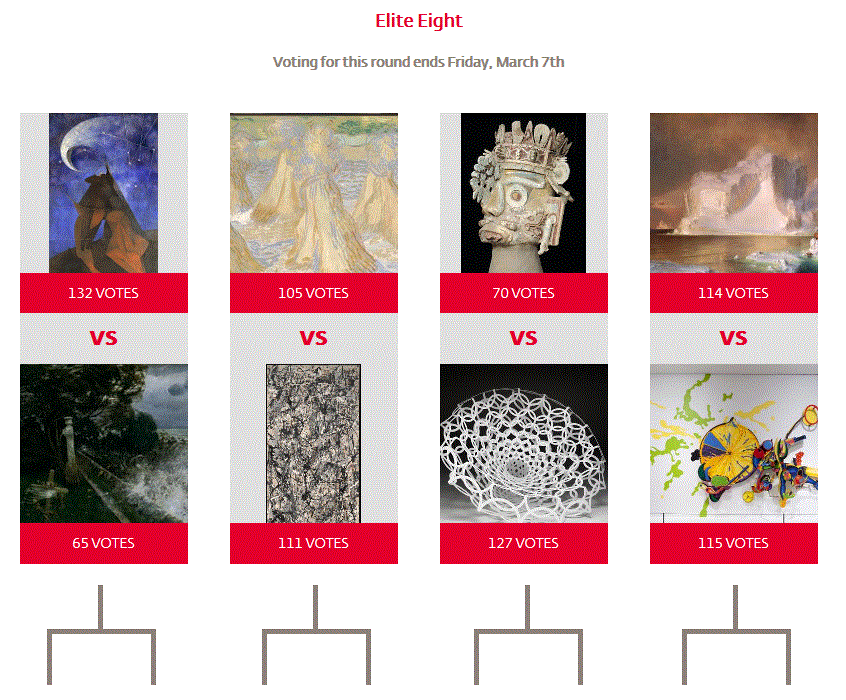
Official behind-the-scenes blog of the Dallas Museum of Art
Check out what’s in store during Spring Break and then cast your vote for the DMA Art Madness Champion at http://www.dma.org/artmadness!

What do March Madness and the DMA have in common? If you are thinking that both are in Dallas, you are correct! This year’s NCAA Men’s Basketball Final Four and Championship games will be played right here in North Texas. But wait, there is SO much more! Here at the DMA we are celebrating Art Madness, our own version of the beloved tournament. DMA Friends picked an artsy Sweet Sixteen that you don’t need a ticket to enjoy, and we are now down to the Elite Eight. Works of art from the Museum’s collection are competing for your vote to determine which artwork is the ultimate champion. If you haven’t voted yet, it’s not too late to get in on the game.
Since basketball is on the brain here, it seemed only fitting that we spend our spring break elevating our game, and we’ve planned an action-packed week of Art Madness family fun for everyone! Enjoy story time in the galleries, family tours, art-making in the studio, family competitions and more all week long in our art and basketball mash-up. We will even have a real piece of the NCAA here at the Museum! Be sure to score a look at the NCAA Championship trophy in the Center for Creative Connections, on view March 11-16.
Can’t get enough of the Madness? Then take an overtime for fun and join us for a Family Block Party on March 14, when we’ll stay open until 9:00 p.m. Families can sketch in the galleries, take a tour of the Art Madness competitors, do some yoga in the galleries, enjoy a puppet show, design trading cards in the studio and more. Everyone will be a winner!
But don’t take our word for it. We asked a family of museum (and sports) experts to walk us through the spring break starting line-up.
Little B-ball enjoyed story time in the galleries, hearing favorite stories and looking at one of the Art Madness competitors.
The entire family used the hands-on activities and games in the Art to Go Family Tote to explore color in some of their favorite paintings.
With art supplies, a healthy dose of imagination and their competitive streak, the B-ball family worked as a team to design a jersey for their Art Madness MVP in the daily Championship Challenge.
Mama B-ball thought yoga was very relaxing and loved finding peaceful inspiration in the art around her. (Little B-ball wasn’t quite as meditative.)
Daddy B-ball couldn’t help but laugh at ventriloquist Nancy Worcester’s hilarious show in the Horchow Auditorium.
Their final conclusion: “Visiting the DMA is a slam dunk!”
Our analysis? Art + Basketball = A surefire hit for the entire family. We hope to see you here March 11-16!
Amanda Blake is the head of family, access, and school experiences at the DMA.
Leah Hanson is the manager of early learning programs at the DMA.
You may have heard about our McDermott Internship Program, a nine-month paid internship for those interested in gaining experience within our Education or Curatorial Departments. As this year’s application deadline of March 7 is fast approaching–only 4 days left to submit your materials!–I thought it would be nice to share some other aspects of the Internship that aren’t listed on our flyer. Of course our McDermott Interns get to experience the full operations of the Museum–exhibitions and programming, research and writing, and interacting with our staff and the public. But thanks to the generosity of the McDermott Foundation, we are also able to provide them with additional experiences beyond the walls of the DMA.
Each of our eight interns is eligible to apply for special funding that can be used toward their professional development, like attending a conference or pursuing classes in continuing education. After being approved for these funds, the interns take part in the experience and then have the opportunity to reflect and summarize it into a report for us. Several interns from year’s class have already taken advantage of this excellent opportunity by attending the annual CAA Conference in Chicago. Not only were they able to attend informative sessions in their areas of art historical interest, they were also given the chance to network with colleagues and gain further advice on transitioning into their future careers.
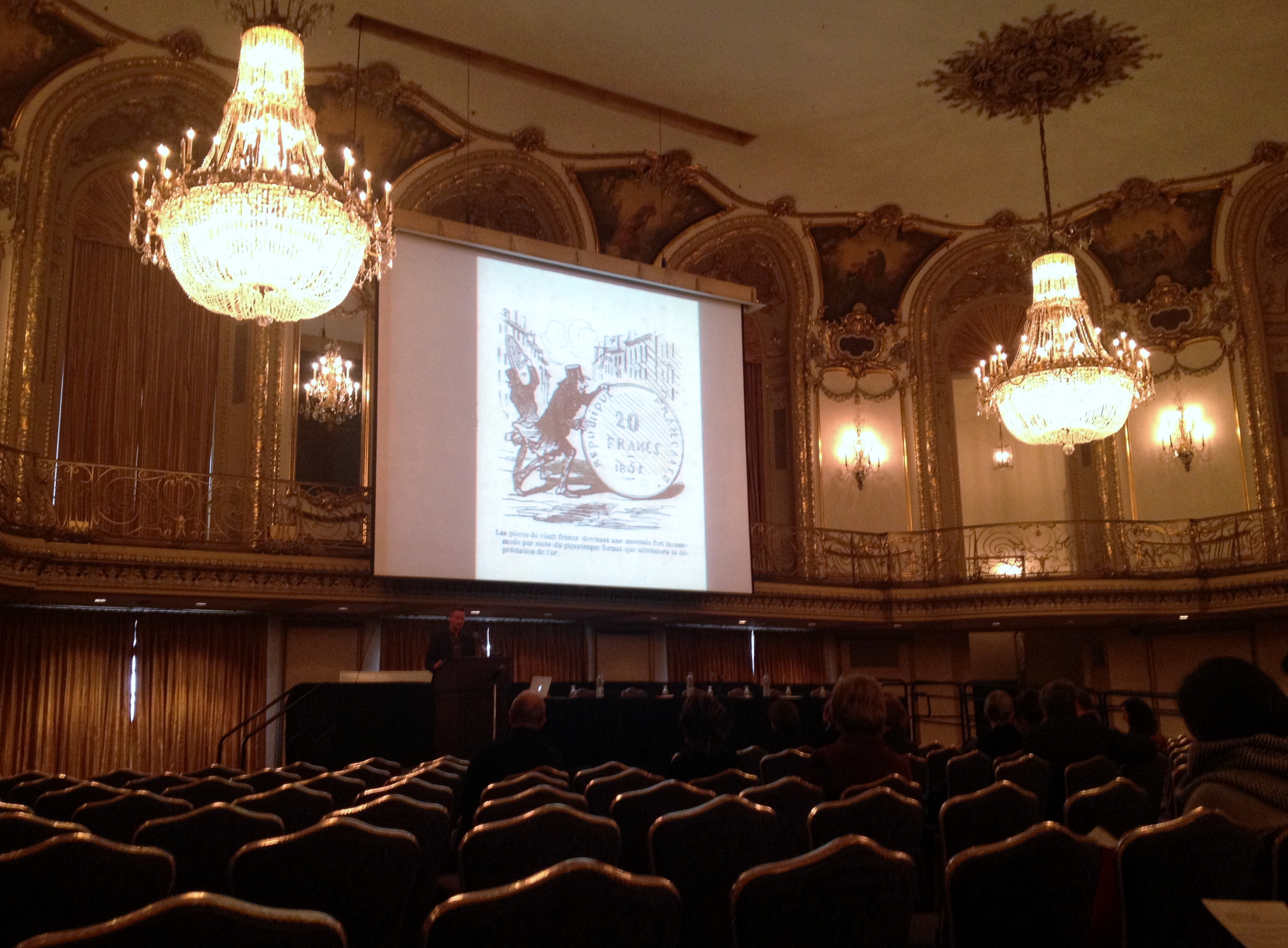
A conference session at CAA
In addition to a focus on professional development, we also place an emphasis on the myriad cultural opportunities available here in DFW. Not only do we visit our museum neighbors in both Dallas and Fort Worth, we also provide tickets to performances here in the Dallas Arts District. So far, our interns have enjoyed attending the ballet and seeing Philip Glass at the Winspear Opera House.
So if you know any interested individuals who would like to experience all this and more, encourage them to finish their applications! We look forward to what next year’s class will bring!
Sarah Coffey
Assistant to the Chair of Learning Initiatives
When I was younger, I loved watching the Oscars. I stayed up late to watch to the very end, and the next day I talked about the awards and speeches and dresses with my classmates. I no longer have the stamina to watch the entire program (it’s sad, I know). But I always look forward to seeing everyone’s wardrobe, whether I catch them live on the Red Carpet or on the Internet the next day. Below are some fabulous dresses and spectacular accessories from the DMA’s collection, in honor of last night’s beautiful women.
Melissa Gonzales is the C3 gallery manager at the DMA.
After attending the Philip Glass and Tim Fein concert at the Winspear Opera House this past Monday night, I was excited to discover that the DMA’s collection includes a lithograph of the composer, completed by his long-time friend Chuck Close. Close is known for his innovative approaches to representing the human face. All of his works explore this theme, depicting his subjects, generally friends and family members, in intimate, large-scale portraits of their shoulders and head. His portraits begin as photographs, which he then carefully transfers to a canvas. Close has experimented with various techniques and materials, including finger-painting, graphite, conté-crayon, pastel, oil and watercolor.
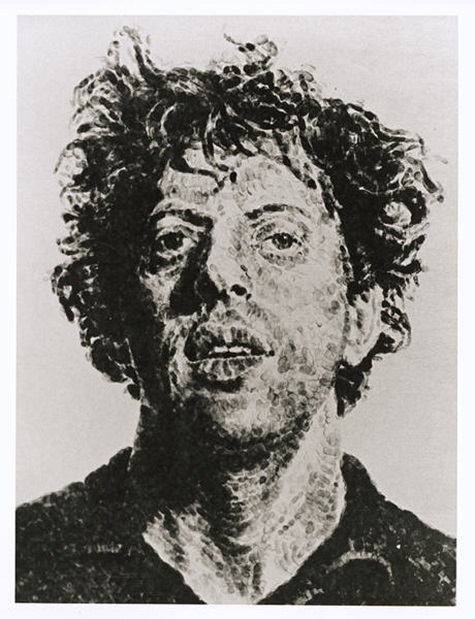
Chuck Close, Phil/Fingerprint, 1981, lithograph, Dallas Museum of Art, Mr. and Mrs. Jake L. Hamon Fund, (c) Chuck Close
Over the course of their four-decade-long relationship, Phil has been the subject of many of Close’s most iconic works; in fact, his image has been used more than any other subject. According to an article published by W magazine in 2007, Close estimates that he has repurposed a 1968 photograph of Glass “150 times or something.” Glass returned the favor in 2005, unveiling a striking and beautiful composition entitled “A Musical Portrait of Chuck Close,” intended to encapsulate the artist’s persona and work. The DMA’s Close work is a 50’’ by 38’’ lithograph of a fingerprint Close completed in 1981. I have always admired Chuck Close’s work, and I recently began to explore my own talents for photorealism. I decided to experiment with Close’s gridwork series, having read that Close used this approach “to break things down into a manageable and solvable problem.” For me, as an amateur artist, this statement provided the confidence I needed to begin my project. Follow my progress below to create your own Close-inspired work.
Step 1: Choose a photograph
As mentioned, all of Close’s portraits depict only the subject’s shoulders and head. This tight cropping helps to focus the piece and also encourages closer consideration of the subject’s individual features. I chose the photograph below for my image.

Step 2: Crop your image
While this project works best with an up-close photograph, do not hesitate to crop or enlarge an existing photograph. Since I knew this artwork would be given as a gift, I chose an image with two subjects, rather than one. After cropping, however, my photograph becomes a manageable project.

Step 3: Divide your image into a grid
Measure the length of your photograph. You want to make sure that the length and width of the photograph is evenly divisible by the size of each unit. For instance, my photograph is 14.5 cm by 10.5 cm so I chose to use 1/2 cm as my base unit. Use a ruler to divide your photograph into units of equal size. I recommend using a pencil so that you can correct a line if need be; graphite also shows up better than other mediums on glossy photograph paper.
Hint: The larger you make your squares, the less time your project will take. Larger squares will make for a more abstract image and smaller will create a more precise, accurate image.

Step 4: Transfer your grid to your canvas or paper
To determine the size of your project, first decide on the size of your new base unit. For my project, I transferred the 1/2 cm units from my photograph to 1 cm on my drawing paper. In total, my final project will be approximately 8.5 by 11 inches. Be sure to consider your dimensions carefully, especially if you plan to frame your final composition.

Step 4: Start your drawing!
I used colored pencil and drawing paper for my project. These materials are easy and user-friendly. If you are familiar with another medium, feel free to use it. After all, Chuck Close likes to experiment, too!
When selecting your colors, you can opt for accuracy or choose a unique theme or palette of your own. This decision may also affect the style of your portrait. You can use the lines to help you create an accurate, photorealistic transfer of your photograph; or you can use a more interpretive, abstract coloration (see Phil above). I chose the latter process. For this process, color each square as an individual unit, independent of the units around it. Don’t worry, it will all add up in the end!
It is easiest to begin in a corner and then work your way up, row by row. You may also want to start with something easy, like the shoulders or clothes before attempting to work on the face. Be patient. You do not want to rush and accidently transfer the wrong section of your photograph. If you get lost, count your square units to get you back on track.

Step 5: Don’t give up
Depending on the number of squares in your artwork, this may be a long process. My picture took me about 16 hours to complete. If you are frustrated, step away and come back to your work tomorrow.
This activity can also be simplified for children. You can choose a simpler subject and/or divide the paper into larger squares. Either way, it is a good way to encourage “close-looking” and practice experimenting with colors.
Step 6: Step back, appreciate your work, and put a frame on it
Great work! I hope you enjoyed this project. If you made an artwork of your own or used this activity in your classroom, please share your creations with us below! Also, if you have suggestions on how we can improve this project, we would value your feedback.
Hint: Adding a frame or border to your artwork can really enhance the overall effect!
Hayley Prihoda is the McDermott Education Intern, Gallery and Community Teaching, at the DMA.
As a lover of dots (also known as spots, polka dots, specks, periods, or decimal points), I am looking forward to next week’s First Tuesday program, Dot to Dot. First Tuesday, which features programming designed for children five and under, will celebrate the beloved dot on Tuesday, March 4, with dot themed games, performances, stories, art-making, and tours.
Dot to Dot‘s programming was inspired by one of my favorite children’s books, The Dot by Peter Reynolds. In this story, a girl named Vashti struggles with drawing. Her teacher challenges her to make a single mark on her paper, unleashing Vashti’s creativity and inspiring a series of dotted artworks. At the end of the story, Vashti shares her newfound excitement for art making with a struggling peer, and the flow of creative inspiration comes full circle.
As an artist and arts educator, this book has a special place in my heart. I have experienced Vashti’s struggle and have also witnessed it in children I have worked with. The Dot’s encouragement to make that first mark of self expression, no matter how small or seemingly insignificant, has positively influenced both my own art-making and my interactions with children.
In anticipation of next week, I’ve included some close-ups of four ‘dot-tastic’ artworks found in the DMA collection. Can you connect the dots to uncover the artworks?
Amelia Wood
McDermott Intern for Family and Access Teaching
Over the next couple of months, as you’re wandering down the concourse of the DMA, you may notice an eclectic mixture of vibrantly colorful paintings, intricate sculptures, detailed music compositions, and even essays on display just outside the Center for Creative Connections. That’s because our 16th annual Young Masters exhibition is underway!
The Young Masters exhibition is the product of a collaboration between the Dallas Museum of Art, AP Arts Strategies and the O’Donnell Foundation, in which Dallas area high school students who are completing AP Art History, Music Theory or Studio Art courses are invited to submit work to be chosen for display. A whopping 732 works were submitted for this year’s exhibition and from those, 60 final works of art were chosen.
Tuesday night marked the DMA’s annual Young Masters Reception and Award Ceremony in which members of the Dallas community came together to recognize and celebrate the talent of this year’s selected students. The night began with family, friends, students, and teachers crowding into the concourse to take photographs with the selected works of art.
The celebratory photographs and mingling were followed by everyone making their way into Horchow Auditorium to recognize each individual student and reveal a selected nineteen students who received top honors in the exhibition. Ceremony attendees heard a reading of the top selected essay, listened to a beautiful performance of the top selected music composition, and learned more about the artistic process and inspiration behind the top selected works of studio art.
Though most awards have been announced, there are still ways that you can get involved with the exhibition. During March and April Late Nights, be on the look out for staff or volunteers who will be handing out People’s Choice Award fliers for you to cast your vote in any of the three exhibition categories. You can also learn more about selected works from the exhibition at the March and April Late Nights when students are interviewed here at the DMA.
Amy Elms
McDermott Intern for Visitor Engagement
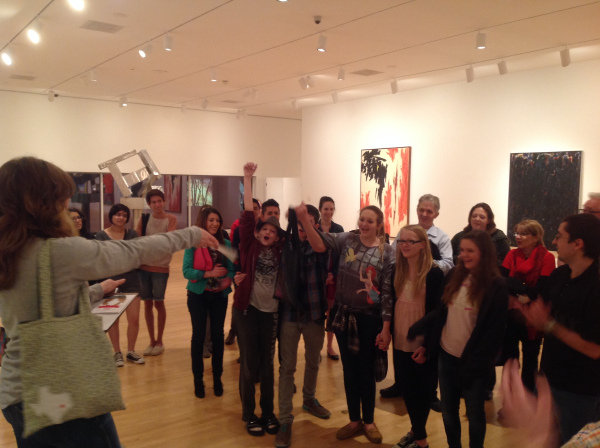
If you are a frequent guest at DMA Late Nights on the third Friday of every month, you may be familiar with interesting riddles like this one:
Love is in the air or bitterness abounds, whatever you may be feeling there is healing in sound! Join us for this melodic Creativity Challenge about love and hate!
[vimeo 87408857 w=500 h=375]
MVI 0450 from A Batson on Vimeo.
These kinds of poems and rhymes are all part of a program called Creativity Challenge which occurs throughout the year and during Late Nights. Visitors sign up to participate as part of a team–equipped with a team name, like The Flaming Chinchillas–to compete in an on-the-spot challenge to create something unique based on a work of art. [vimeo 87408856 w=500 h=375]
MVI 0458 from A Batson on Vimeo.
Many times the challenges engage a variety of learning styles in order to have visitors view art in a new and different way. Occasionally visitors will dance, sing, write, act, build, etc. within the challenge. They work with others in a team that allows them to build on each other’s strengths, resulting in a dynamic show at the end of their challenge. [vimeo 87408861 w=500 h=375]
MVI 0457 from A Batson on Vimeo.
This past Friday evening, February 21, 2014, ten teams of challengers faced off to create a musical instrument and original composition about a work of art in the DMA’s contemporary collection. The teams then had to create and perform in front of the sixty people who attended! The composition was to be a love song or a song of complete disgust to an assigned work of art. Coming off the heels of Valentine’s day–I thought this challenge would be appropriate! Check out some of these incredible interpretations!
[vimeo 87408863 w=500 h=375]
MVI 0448 from A Batson on Vimeo.

Creativity Challenge in the Hoffman Gallery
Are you up to the challenge? Join me and the other teams next Late Night on March 21st, 2014, for a Creativity Challenge that will be sure to entice your taste buds!
Amanda Batson
C3 Program Coordinator
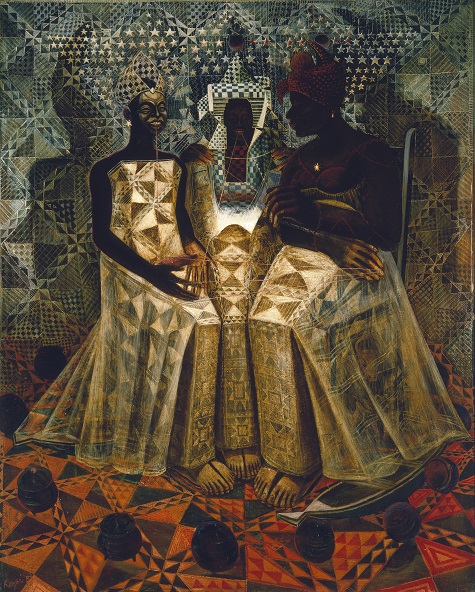
John Thomas Biggers, Starry Crown, 1987, acrylic and mixed media on Masonite, Dallas Museum of Art, Museum League Purchase Fund
I began research on John Biggers’ Starry Crown, which is on view in the DMA’s Center for Creative Connections (C3), in order to create interactive elements in the gallery for visitors. When I began, it was clear that the symbols and imagery in the painting hold a lot of information that needed to be unpacked. I found that one of the overriding themes in this piece, and other works by Biggers, is the transfer of knowledge by women across generations. The three figures depicted here reference important women in Biggers’ life, and the string that connects them alludes to the sharing of knowledge, traditions and family history through dialogue.
As an art educator, I found it important to help visitors connect with this work of art by considering their own similar experiences. I started by posting prompts like “When I was _____ (age), ______ (an important woman in your life) taught me _________.” The responses were inspiring, sweet and at times comical. These snippets were interesting, but what I really wanted was the great stories that these sentences only hinted at.
For this, the Center for Creative Connections enlisted the help of DMA Writer-in-Residence Shay Youngblood. During Late Nights, Shay interviewed visitors about family traditions and lessons they learned from important women in their lives. We chose a handful of stories from the dozens collected, and then Shay reimagined them through the lens of a creative writer and presented them at the January 2014 Late Night. Visit DMA.mobi and enter stop number 125 to listen to our visitors’ stories.
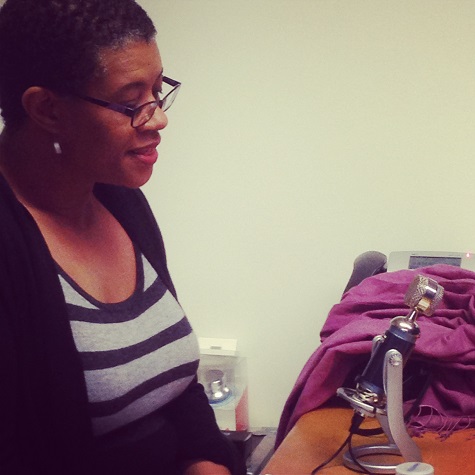
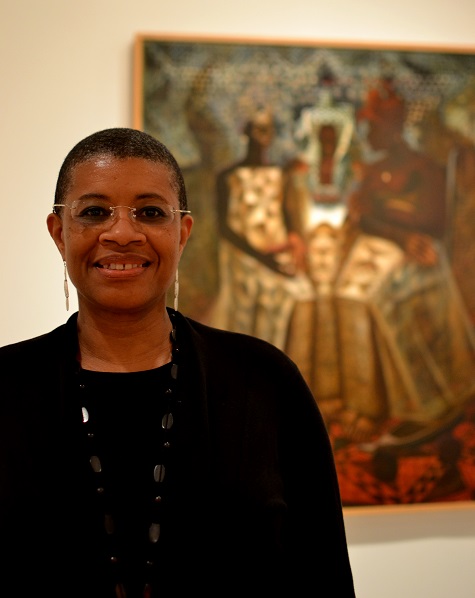
Jessica Fuentes is the C3 gallery coordinator at the DMA.
Thanks to the support of the DMA and the Eugene McDermott Foundation, this past week two of my fellow McDermott Interns and I had the opportunity to attend the College Art Association Conference in Chicago. Having never before attended a conference of this magnitude, I was not sure what to expect when we arrived at the Hilton Chicago early Wednesday morning. The pictures below capture a few of my favorite moments from the conference, including the architecture of the Hilton, my favorite lecture series, and the Chicago skyline covered in a soft, white snow. Enjoy!
The hotel was packed with art historians, museum educators, professors, and curators rushing to attend their first session of the conference. I was immediately impressed with the variety of attendees, diversity of the sessions offered, and the grandeur of our location. The Hilton Chicago was breathtaking and I was happy to wander the halls of this beautiful building, originally opened in 1927. The lobby featured Roman columns, a vaulted ceiling, and a grand staircase.

I took this photograph during the question and answer session that followed one of my favorite presentations, called “Finding Common Ground: Academics, Artists, and Museums.” It included presentations by colleagues from various academic and cultural institutions across the country.
Just outside the Art Institute of Chicago, someone had decided to help a few statues stay warm with winter vests and scarves. It was a great example of the Chicago community interacting with the city’s public art installations.
Millennium Park in downtown Chicago features fantastic public art like Cloud Gate, aka the Bean. No matter how many times I visit this sculpture, I always enjoy the experience. Fun fact: when you stand in the center, your image is reversed on the ceiling and your reflection can be found all around the interior. Next time you visit, try to count how many times you can find your reflection!
As a native Chicagoan, it was wonderful to go home and explore the city through the eyes of a tourist! At the end of the week, however, I was ready to return to the sunny, 70 degree weather here in Dallas. 🙂
Hayley Prihoda
McDermott Intern for Gallery and Community Teaching